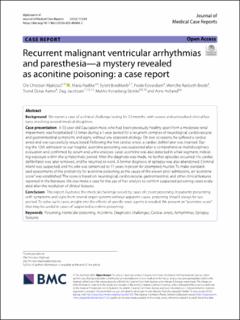| dc.description.abstract | Background: We report a case of a clinical challenge lasting for 12 months, with severe and unresolved clinical features involving several medical disciplines.
Case presentation: A 53-year-old Caucasian male, who had been previously healthy apart from a moderate renal impairment, was hospitalized 12 times during a 1-year period for a recurrent complex of neurological, cardiovascular, and gastrointestinal symptoms and signs, without any apparent etiology. On two occasions, he suffered a cardiac arrest and was successfully resuscitated. Following the first cardiac arrest, a cardiac defibrillator was inserted. During the 12th admission to our hospital, aconitine poisoning was suspected after a comprehensive multidisciplinary evaluation and confirmed by serum and urine analyses. Later, aconitine was also detected in a hair segment, indicating exposure within the symptomatic period. After the diagnosis was made, no further episodes occurred. His cardiac defibrillator was later removed, and he returned to work. A former diagnosis of epilepsy was also abandoned. Criminal intent was suspected, and his wife was sentenced to 11 years in prison for attempted murder. To make standardized assessments of the probability for aconitine poisoning as the cause of the eleven prior admissions, an “aconitine score” was established. The score is based on neurological, cardiovascular, gastrointestinal, and other clinical features reported in the literature. We also make a case for the use of hair analysis to confirm suspected poisoning cases evaluated after the resolution of clinical features.
Conclusion: This report illustrates the medical challenge raised by cases of covert poisoning. In patients presenting with symptoms and signs from several organ systems without apparent cause, poisoning should always be suspected. To solve such cases, insight into the effects of specific toxic agents is needed. We present an “aconitine score” that may be useful in cases of suspected aconitine poisoning. | en_US |

